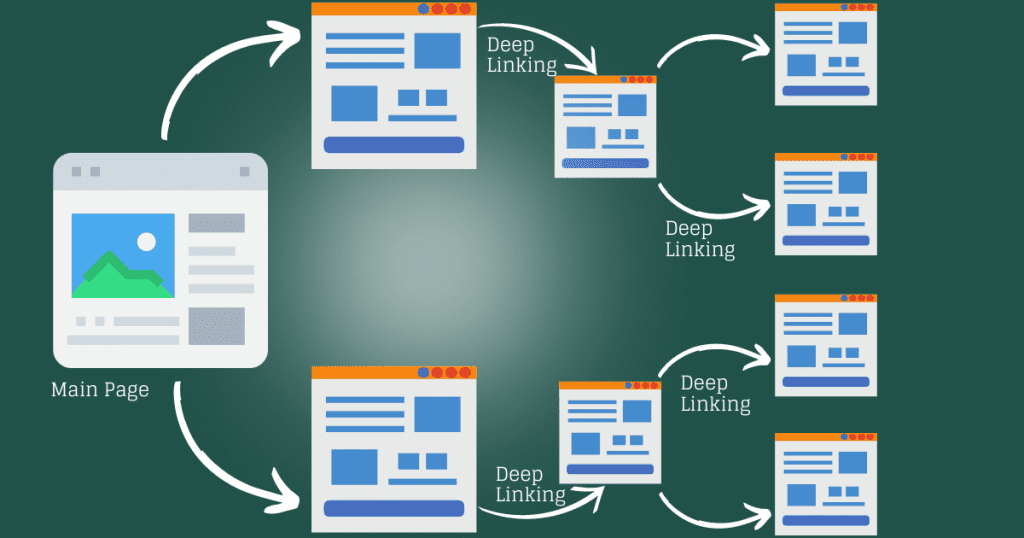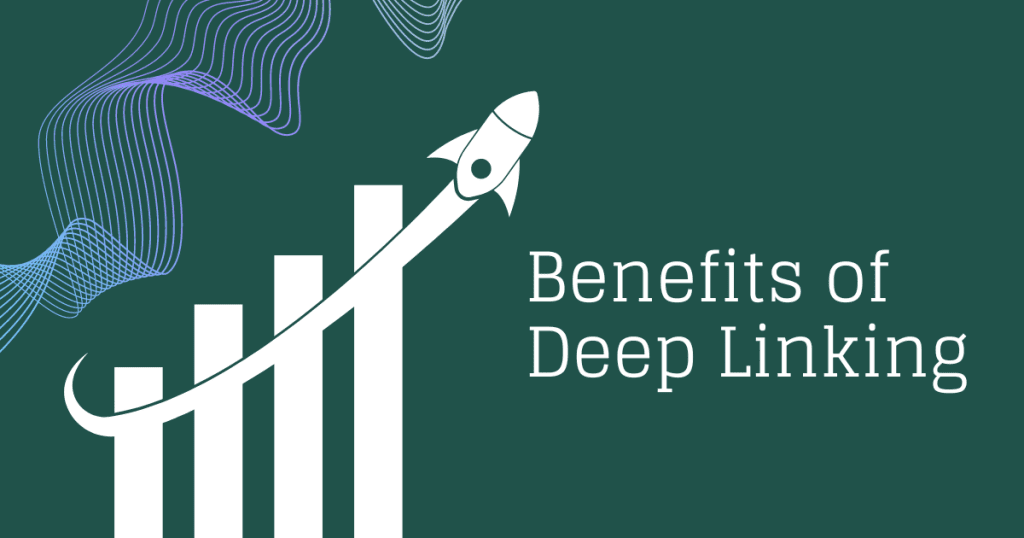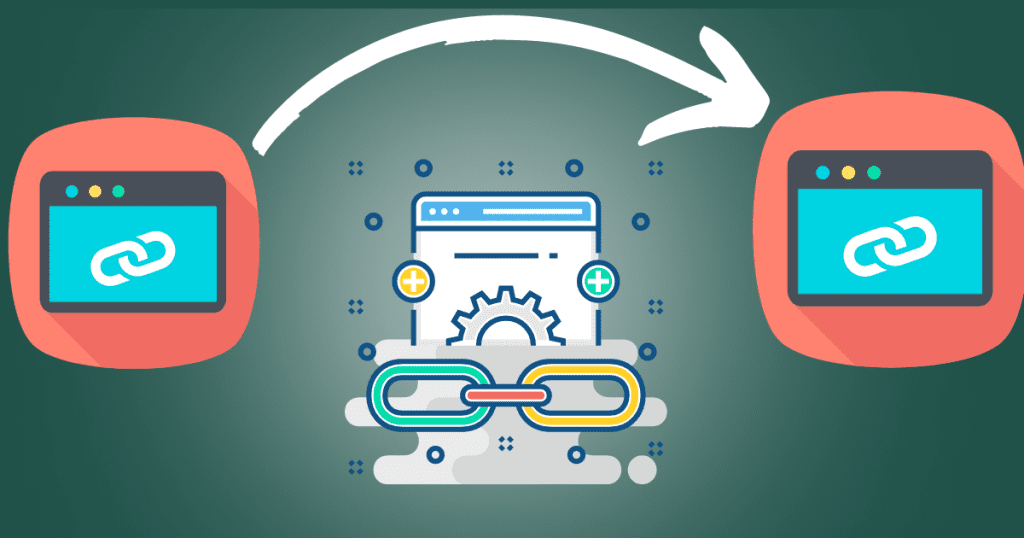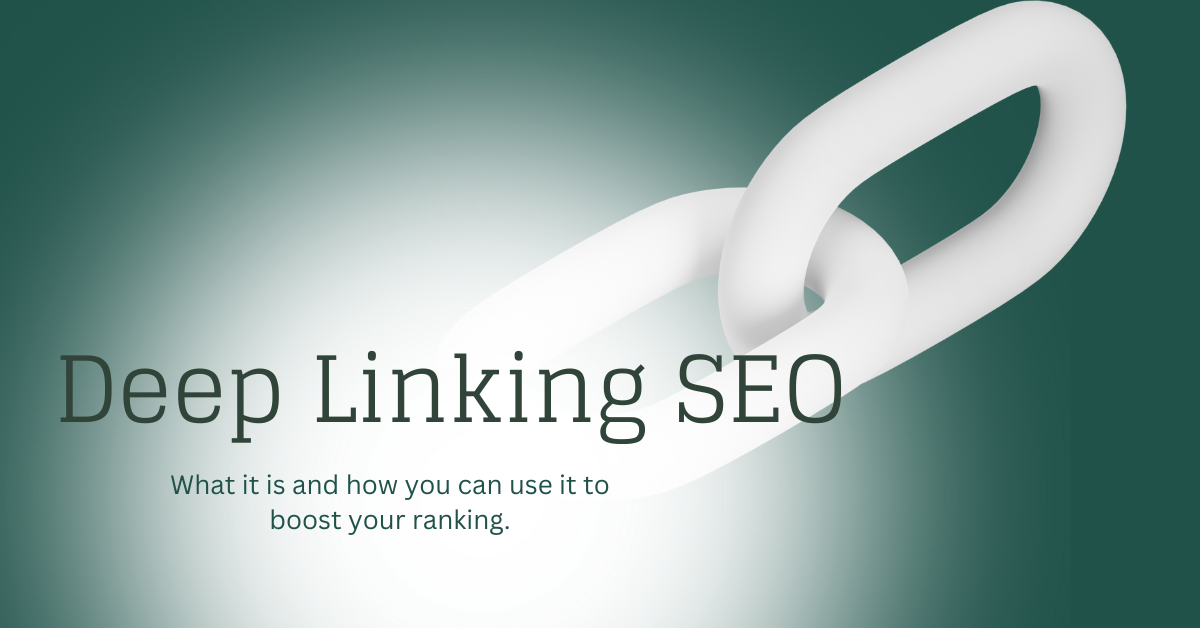How far would you scroll through a website if what you wanted was right on the homepage? Not very far, I’d reckon. That’s why deep linking is so important for SEO.
Deep links allow users to land directly on the most relevant page that matches their search intent. And the same goes for search engines – deep links help them index and direct users to the best content faster.
But what exactly are deep links, and how can you implement deep linking for improved SEO? This comprehensive guide has all the answers.
What is Deep Linking?

Simply put, deep linking allows users to start on a website home page and link out to a specific, targeted lower-level page. Instead of displaying content through in-site navigation, deep links point the user directly to the most topically relevant webpage.
So rather than navigate through category and subcategory web pages to arrive at a hyper-specific information target, the user skips straight there with higher usability.
Deep links can connect to internal site pages or pages on external websites. Either way, deep linking helps search engines understand precisely where the most focused content lives across domains.
And crafting a deep linking content strategy comes with a wide range of SEO and UX benefits.
Benefits of Deep Linking for SEO

Implementing deep links across your website pages and external sites provides tremendous SEO value by:
- Improving Page Ranking: Deep links allow search engines to better understand the structure of your site and the relationship between pages. Pages receiving a lot of well-optimized deep links can dramatically boost ranking potential.
- Enhancing Website Architecture: An interlinking structure powered by deep links offers clearer site navigation for bots. This improves crawl efficiency and site architecture analysis.
- Driving User Engagement: When users land directly on the most relevant page for their query, they consume and engage more with the content. This signals search engines about the quality of individual pages.
- Building Domain Authority: The more niche, high-authority sites link deeply into relevant pages on your website, the more authority passes onto your domain.
- Boosting Conversions: Hyper-relevant landing pages you deep link to can convert visitors into customers at a much higher rate.
Types of Deep Links and Use Cases
When strategizing your deep linking SEO approach, consider these primary types of deep links:
Internal Deep Links
These are hyperlinks connecting various pages within your own website, typically across siloed sites. For example, an ecommerce site could internally deep link product pages from relevant blog posts.
External Deep Links
External links go a level deeper by directing users from your web pages out to a targeted page on another domain. An external link could connect from your website guide to a specific product review article on another industry site.
App Deep Links
For websites with native mobile apps, you can deep link directly into the app to route users precisely to in-app content from search results.
Deep Links for Social
Targeted deep links work extremely well for showcasing content across social platforms like Facebook and Twitter. Instead of users landing on the homepage after clicking social posts, you direct them to the exact page they want to consume.
The right deep linking strategy depends on your business goals. But executing correctly provides both user experience and SEO wins.
How to Implement Deep Linking

Take full advantage of deep links in your SEO approach by following technical guidance alongside content strategies:
Technical Implementation
Leverage deep linking plugins or URL builders like Bitly to correctly structure deep links across domains. Focus on:
Deep Linking Setup
- Create a site schema mapping out your content hierarchy
- Decide which main web pages will internally deep link to underlying content
- Set rules for semantic relevance (don’t link randomly!)
- Tag specific pages for external partners to deep link into
Deep Link Testing
- Construct deep link URLs using URL builder tools
- Verify constructed links route correctly by clicking them
- Check redirects go precisely to target landing page
- Fix any broken links pointing pages not intended
Deep Link Promotion
- Identify main site pages that will feature clickable deep links
- Place visible callouts where deep links are implemented directing to underlying content pages
- Communicate in anchor text when links will navigate away from current domain
- Ask partner sites to include link attribution referencing your domain
Content Strategies
Deep links technically transport users places, but still require thoughtful content integration:
Anchor Text Optimization
- Research target keywords that align with each deep link landing page
- Craft descriptive, semantic anchor text using those terms
- Keep anchor length natural – no overstuffing!
- Use latent semantic indexing (LSI) keywords for variety
Contextual Placement
- Deep links should occur at logical insertion points relevant to surrounding discussion
- Don’t force deep links where they don’t fit the content flow
- Write natural transitions to introduce each deep link
Create Deep-Linkable Resources
- Develop dedicated content assets ideal for deep linking opportunities:
• Detailed case studies showcasing client examples • In-depth guide books explaining complex topics • Data-rich reports with cited industry research - Format resources for scannability
- Include useful, shareable charts and graphs
- Publish resources behind lead gen forms to capture visitor info
Best Practices for Deep Linking SEO

When developing a layered deep linking strategy with enhanced SEO, avoid putting convenience too far ahead of experience with these best practices:
Prioritize User Experience
While technically any site page can deep link anywhere, relevance matters most. Avoid confusing users with out-of-context deep links.
Avoid Excessive Deep Linking
Don’t over-optimize pages with deep links as this feels spammy to users. Allow natural content flow.
Monitor Performance
Use analytics to track CTR and conversions rates for deep links. Reduce or improve links based on findings.
Stay Updated
Monitor search algorithm updates that determine ideal UI patterns and deep linking best practices.
Advanced Deep Linking SEO Techniques

Ready to master advanced, technical deep linking methods? Explore next-level SEO here:
- Add Structured Data markup to boost deep link visibility for search bots.
- Personalize deep links using JavaScript redirects to match user preferences.
- Enable cross-platform deep linking between web and mobile apps with analytics tracking.
Conclusion
As you navigate the intricate web of SEO, remember that deep linking is not just a tactic, but a strategic decision. By strategically weaving relevant deep links throughout your content, you empower your website to become a dynamic hub of rich information, guiding users directly to the heart of what they seek. This targeted navigation not only elevates user experience, but also signals clarity and authority to search engines, propelling your pages to the top of the ranks.
Q. How does Deep Linking differ from Regular Linking?
Regular linking directs to a website’s homepage, while deep linking guides users to specific internal pages, enhancing user experience and SEO by targeting relevant content directly.
Q. How can Deep Linking benefit user experience?
By guiding users directly to relevant content, deep linking streamlines navigation, saving time and providing a seamless experience, resulting in increased user satisfaction.
Q. Does Deep Linking impact search engine rankings?
Yes, deep linking positively influences rankings by showcasing the depth and quality of content. It helps search engines understand the site structure and prioritize valuable information.
Q. Can Deep Linking be applied to external websites?
While deep linking typically refers to internal links, it can also be beneficial externally. When linking to specific content on other sites, ensure relevancy and value for users.
Q. Are there any potential drawbacks to Deep Linking?
Overlinking or using irrelevant anchor text can be counterproductive. Maintain a natural link profile, and focus on enhancing user experience rather than manipulating search algorithms.

